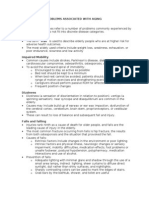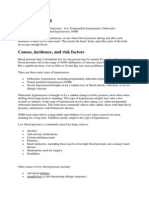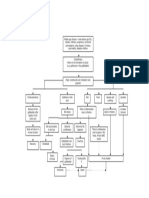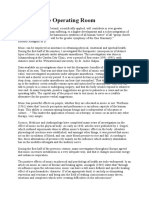Delusion and Hallucination
Delusion and Hallucination
Uploaded by
Riezky FebriyantiCopyright:
Available Formats
Delusion and Hallucination
Delusion and Hallucination
Uploaded by
Riezky FebriyantiCopyright
Available Formats
Share this document
Did you find this document useful?
Is this content inappropriate?
Copyright:
Available Formats
Delusion and Hallucination
Delusion and Hallucination
Uploaded by
Riezky FebriyantiCopyright:
Available Formats
Delusion Delusional Disorder
Delusions are false fixed beliefs not in keeping with the culture. They are among the most interesting of
psychiatric symptoms because of the great variety of false beliefs that can be held by so many people and because they are so difficult to treat. The diagnosis of delusional disorder is made when a person exhibits nonbizarre delusions of at least 1 month's duration that cannot be attributed to other psychiatric disorders. Nonbizarre means that the delusions must be about situations that can occur in real life, such as being followed, infected, loved at a distance, and so on; that is, they usually have to do with phenomena that, although not real, are nonetheless possible. Several types of delusions may be present and the predominant type is specified when the diagnosis is made.
Delusion A false belief based on incorrect inference about external reality that is firmly sustained despite what
almost everyone else believes and despite what constitutes incontrovertible and obvious proof of evidence to the contrary. The belief is not one ordinarily accepted by other members of the person's culture or subculture (e.g., it is not an article of religious faith). When a false belief involves a value judgment, it is regarded as a delusion only when the judgment is so extreme as to defy credibility. Delusional conviction occurs on a continuum and can sometimes be inferred from an individual's behavior. It is often difficult to distinguish between a delusion and an overvalued idea (in which case the individual has an unreasonable belief or idea but does not hold it as firmly as is the case with a delusion).
Delusions are subdivided according to their content :
Bizarre A delusion that involves a phenomenon that the person's culture would regard as totally implausible. 'Delusional jealousy The delusion that one's sexual partner is unfaithful. Erotomanic A delusion that another person, usually of higher status, is in love with the individual. Grandiose A delusion of inflated worth, power, knowledge, identity, or special relationship to a deity or famous person. Of being controlled A delusion in which feelings, impulses, thoughts, or actions are experienced as being under the control of some external force rather than being under one's own control. Of reference A delusion whose theme is that events, objects, or other persons in one's immediate environment have a particular and unusual significance. These delusions are usually of a negative or pejorative nature, but also may be grandiose in content. This differs from an idea of reference, in which the false belief is not as firmly held nor as fully organized into a true belief. Persecutory A delusion in which the central theme is that one (or someone to whom one is close) is being attacked, harassed, cheated, persecuted, or conspired against. Somatic A delusion whose main content pertains to the appearance or functioning of one's body. Thought broadcasting The delusion that one's thoughts are being broadcast out loud so that they can be perceived by others. Thought insertion The delusion that certain of one's thought are not one's own, but rather are inserted into one's mind. Mood-congruent psychotic features Delusions or hallucinations whose content is entirely consistent with the typical themes of a depressed or manic mood. If the mood is depressed, the content of the delusions or hallucinations would involve themes of personal inadequacy, guilt, disease, death, nihilism, or deserved punishment. The content of the delusion may include themes of persecution if these are based on self-derogatory concepts such as deserved punishment. If the mood is manic, the content of the delusions or hallucinations would involve themes of inflated worth, power, knowledge, or identity, or a special relationship to a deity or a famous person. The content of the delusion may include themes of persecution if these are based on concepts such as inflated worth or deserved punishment. Mood-incongruent psychotic features Delusions or hallucinations whose content is not consistent with the typical themes of a depressed or manic mood. In the case of depression, the delusions or hallucinations would not involve themes of personal inadequacy, guilt, disease, death, nihilism, or deserved punishment. In the case of mania, the delusions or hallucinations would not involve themes of inflated worth, power, knowledge, or identity, or a special relationship to a deity or a famous person. Examples of mood-incongruent psychotic features include persecutory delusions (without self-derogatory or grandiose content), thought insertion, thought broadcasting, and delusions of being controlled whose content has no apparent relationship to any of the themes listed above.
Etiology :
As with all major psychiatric disorders, the cause of delusional disorder is unknown. Family studies increased prevalence of delusional disorder and related personality traits (egg. suspiciousness, jealousy, and secretiveness) in the relatives of delusional disorder probands.
Biological factors
neurological conditions most commonly associated with delusions are conditions that affect the limbic system and the basal ganglia. patients whose delusions are caused by neurological disease that does not affect cerebral cortex tend to have complex delusions, similar to those in-patients with delusional disorder. conversely, patients with neurological disorder with intellectual impairments often have simple delusions, unlike those in-patients with delusional disorder. Psychodynamic factors Freud`s contributions In Dr Schreber case, Freud theorized that denial and projection defend against unconscious homosexual tendencies. Because homosexuality is consciously inadmissible to some patients, male patients deny this feeling of I love him and change them by reaction formation into I do not love him. Patient further transform these feelings through projection into It is not I who hate him; it is he who hates me. In a full-blown paranoid state, the feeling is elaborated into I am persecuted by him. In erotomanic delusions, male patients change I love him to I love her. In delusional grandiosity I do not love him becomes I love myself. Freud also believed that unconscious homosexuality causes delusions of jealousy the man whom a paranoid patient suspects his wife of loving is a man to whom the patient feels sexually attracted. Clinical evidence has not supported Freud`s thesis. Paranoid pseudocommunity A perceived community of plotters. This delusional entity hypothetically binds together projected fears and wishes to justify the patient`s aggression and to provide a tangible target for the patient`s hostilities. Other psychodynamic factor Hypersensitivity and feelings of inferiority have been hypothezed to lead, through reaction formation and projection, to delusions of superiority and grandiosity. Delusions of erotic ideas have been suggested as replacements for feelings of rejection. Critical and frightening delusions are often described as projections of superego criticism. Somatic delusions can be psychodynamically explaned as a regression to the infantile narcissistic state, in which patients withdraw emotional involvement from other people and fixate on their physical selves.
Type : DSM-IV specifies seven types of delusional disorder
Erotomanic type: delusions that another person, usually of higher status, is in love with the individual. Grandiose type: delusions of inflated worth, power, knowledge, identity, or special relationship to a deity or famous person. Jealous type: delusions that individuals sexual partner is unfaithful. Persecutory type: delusions that the person (or someone to whom the person is close) is being malevolently treated in some way. Somatic type: delusions that the person has some physical defect or general medical condition. Mixed type: delusions characteristic of more then one of the above types but no one theme predominates. Unspecified type: Persecutory and jealous types are most common, and erotomanic and somatic types are the most unusual. Other delusions Capgrass syndrome is the delusion that familiar people have been replaced by identical impositors. Fregolis phenomenon is the delusion that a persecutor is taking on a variety of faces, like an actor. Lycanthropy is the delusion of being a werewolf. Heutoscopy is the false belief that one has a double. Cotards syndrome was originally called delire de negation; those with the syndrome may believe that they have lost everything possessions, strenght, and even bodily organs, such as the heart.
Clinical Features: Mental Satatus
General description.Mental status examination is usually remarkably normal except for the presence of markdly abnormal delusional system. Mood, feelings and affect.Patients' moods are consistent with the content of their delusions( e.g. patient with grandiose delusion is euphoric; one with persecutory delusions is suspicious ). Perceptual disturbances.Patients with delusional disorder do not have prominent or sustained hallucinations. Tactile or olfactory hallucinations may be present if they are consistent with the delusion (e.g. somatic delusion of body odor). Thought . Disorder of thought content in the form of delusions is the key symptom of the disorder. The delusions are usually systematized and are characterized as being possible (e.g. delusions of being persecuted , of having an unfaithful spouse , of being infected with a virus, etc.). This examples of
delusional content contrast with the bizarre and impossible delusional content in some patients with schizophrenia. The delusional system itself may be complex or simple. Sensorium and cognition. Patients usually have no abnormality in orientation unless they have a specific delusion about a person, place , or time.Memory and other cognitive processes are intact in these patients. Impulse control.Clinicians must evaluate patients with delusional disorder for ideation or plans to act on their delusional material by suicide, homicide or other violence. If patients are unable to control their impulses hospitalization is probably necessary. Judgment and insight. These patients have virtually no insight in to their condition and are almost always brought to the hospital by the police, family members or employers.
Differential Diagnosis: Delusions can accompany many medical and neurological illnesses.
Neurological and medical conditions that can present with delusion Basal ganglia disorders-Parkinson's disease, Huntington 's disease Deficiency states B12,folate,thiamine, niacin Delirium Dementia- Alzheimer's disease, Pick's disease Endocrinopathies-adrenal,thyroid,parathyroid Limbic system disorders-epilepsy, cerebrovascular diseases,tumors Systemic - hepatic encephalophathy, hypercalcemia, hyopglycemia, porphiria, uremia malingering and factitious disorder with predominantly psychological signs and symptoms schyzophrenia, mood disorders, obsessive-conpulsive disorder, somatoform disorders and paranoid personality disorder drug- induced amphetamines, anticholinergics, antidepressants, antihipertensives, antituberculoses drugs, antiparkinson agents, cimetidine,cocaine, disulfiram(Antabus),hallucinogenes Delusional disorder is distinguished from schyzophrenia buy the absence of other schyzophrenic symptoms and buy the nonbizarre quality of the delusions. The somatics type of delusional disorder may resemble depressive disorder or somatoform disorder. The somatic type of delusional disorder is differentiated from depressive disorder buy the absence of other signs of depression and buy the lack of a pervasive quality to the depression. Delusional disorder can be differentiated from somatoform disorders buy the degre to which the somatic believ is held buy the pationt. Patients with somatoform disorders allow for possibility that their disorder does not exist, whereas patients with delusional disorder have no duobth of it's reality.
Hallucinations
Imaginary sensations, such as seeing, hearing, or smelling things that do not exist in the real world Type of Hallucinations Auditory Characteristic Hearing noises or sounds most commonly in the form of voice. Audible thoughts in which the patient hears voices that are speaking what the patient is thinking and commands that tell the patient to do something, sometimes harmful or dangerous Observable Behaviour Moving eyes back and forth as if looking to see who or what is talking. Listening intently to another person who is not speaking or to inanimate object such as a piece of furniture. Engaging in conversation with an inanimate object or with an invisible person. Moving mouth as if speaking or responding to a sound. Responding to an odor with terror, as in smelling fire or blood. Throwing a blanket or pouring water on another person as if putting out a fire. Suddenly appearing startled, frightened or terrified by another person, an inanimate object, or by apparent stimulus. Suddenly running into another room .
Visuals
Olfactory
Visual Sees a person or object that is not present. Visual stimuli in the form of flashes of light and figures. Visions can be pleasant or terrifying as in seeing monsters . Perceives an odor that actually is not present. Putrid, foul and rancid smells of a repulsive nature such as blood, urine or feces. Occasionally the odors can be pleasant.
Wrinkling nose as if smelling something horrible Smelling parts of the body Smelling the air while walking toward another person. Responding to an odor with terror, as in smelling fire or blood.
Gustatory
Tactile
Kinesthetic
Experiences a taste that is not present and frequently is bitter or strong. Putrid, foul and rancid tastes of a repulsive nature such as blood, urine or feces Experiences the feeling of a touch Feeling electrical sensations coming from the ground, inanimate objects or other people Feeling body functions such as blood pulsing through veins and arteries, food digesting or urine forming Sensation of movement while standing motionless
Responding to an odor with terror, as in smelling fire or blood. Throwing a blanket or pouring water on another person as if putting out a fire. Spitting out food or a beverage Refusing to eat, drink or take medicines Suddenly leaving the dinner table Slapping self as if putting out a fire Jumping up and down on the floor as if avoiding pain or other stimuli on the feet. Verbalizing and/or obsessing about body processes Refusing to complete a task that may require a part of the body that patient believes is not working Steadying oneself while grabbing onto furniture
Agitation
Definition: -A mental state of extreme emotional disturbance. -The act of agitating something; causing it to move around (usually vigorously) -Kegelisahan atau aktivitas motoric yang berlebihan dan tidak bertujuan, biasanya dihubungkan oleh keadaan tegang atau anxietas. Also called psychomotor agitation
Riezky Febriyanti 130110110064- D2
You might also like
- (1479683X - European Journal of Endocrinology) Geographic Variations in The Frequency of Thyroid Disorders and Thyroid Peroxidase Antibodies in Persons Without Former Thyroid Disease Within GermanyDocument9 pages(1479683X - European Journal of Endocrinology) Geographic Variations in The Frequency of Thyroid Disorders and Thyroid Peroxidase Antibodies in Persons Without Former Thyroid Disease Within GermanyArul ThiyagarajanNo ratings yet
- Phenylketonuria (PKU) : PH Arn, Nemours Children's Clinic, Jacksonville, FL, USADocument3 pagesPhenylketonuria (PKU) : PH Arn, Nemours Children's Clinic, Jacksonville, FL, USAHappy612No ratings yet
- Delusional Disorder DSM 5Document11 pagesDelusional Disorder DSM 5Mohamed Asri Zaini100% (1)
- Different Types of DelusionDocument3 pagesDifferent Types of Delusionyhielv0% (1)
- Pseudo HallucinationDocument7 pagesPseudo HallucinationAnonymous gUjimJKNo ratings yet
- Psychiatry Nursing Seminar: Delusion DisordersDocument84 pagesPsychiatry Nursing Seminar: Delusion DisordersGulmoharNo ratings yet
- Crohn's DiseaseDocument8 pagesCrohn's DiseaseShannen Madrid Tindugan100% (1)
- Psychiatry 2 - Compilation (Midterm and FinalsDocument14 pagesPsychiatry 2 - Compilation (Midterm and FinalsRavi Singh RathoreNo ratings yet
- What Is Diabetes? What Causes Diabetes?: Fast Facts On DiabetesDocument6 pagesWhat Is Diabetes? What Causes Diabetes?: Fast Facts On DiabetesAlfred Melvin SolivaNo ratings yet
- Tetanus PresentationDocument132 pagesTetanus PresentationRinrin de BelenNo ratings yet
- Delusional DisorderDocument4 pagesDelusional DisorderDr-Mohamed EssawyNo ratings yet
- ObjectivityDocument13 pagesObjectivityDeepu JoseNo ratings yet
- What Is DiabetesDocument34 pagesWhat Is DiabetesSunil RawatNo ratings yet
- Boils and Carbuncles: (Mayo Clinic)Document15 pagesBoils and Carbuncles: (Mayo Clinic)Jimmy ThomasNo ratings yet
- Electroconvulsive TherapyDocument2 pagesElectroconvulsive TherapyRiz BorbonNo ratings yet
- Hydatidiform MoleDocument18 pagesHydatidiform Molejean thereseNo ratings yet
- Paranoid Personality Disorder Symptoms1Document10 pagesParanoid Personality Disorder Symptoms1xerah0808No ratings yet
- EuthanasiaDocument16 pagesEuthanasiaTheresa BreadNo ratings yet
- Case Study On AsthmaDocument3 pagesCase Study On AsthmaNurudeen Ibrahim100% (1)
- Psych Typical Manif 1Document10 pagesPsych Typical Manif 1Arfi FachrulNo ratings yet
- Acute GastroenteritisDocument27 pagesAcute GastroenteritisEvelyn MedinaNo ratings yet
- Alzheimer Disease: Petra Nowotny, Jennifer M Kwon, Alison M GoateDocument6 pagesAlzheimer Disease: Petra Nowotny, Jennifer M Kwon, Alison M GoatedineshhissarNo ratings yet
- Case Presentation Second Year 2nd SemesterDocument36 pagesCase Presentation Second Year 2nd SemesterJohn Robert PescadorNo ratings yet
- Journal of Endocrine DisordersDocument9 pagesJournal of Endocrine DisordersAustin Publishing GroupNo ratings yet
- GentamicinDocument2 pagesGentamicinDeprama Sutikti100% (1)
- Pathophysiology of Copd: Prepared By: Joseph Mari Jess R. EnanoDocument20 pagesPathophysiology of Copd: Prepared By: Joseph Mari Jess R. Enanojoyrena ochondraNo ratings yet
- General Concepts ProtozoaDocument9 pagesGeneral Concepts ProtozoaRoshan PMNo ratings yet
- The Nature of Nursing 2Document12 pagesThe Nature of Nursing 2twy113No ratings yet
- Common Health Problems Associated With AgingDocument7 pagesCommon Health Problems Associated With AgingAnjo AprueboNo ratings yet
- Drug Index Updated2Document113 pagesDrug Index Updated2tam meiNo ratings yet
- History Psychiatry ANAMNESISDocument21 pagesHistory Psychiatry ANAMNESISDr. BrainNo ratings yet
- Neurological Examination of The NewbornDocument21 pagesNeurological Examination of The Newborncristieristiie100% (1)
- The Antibiotic Self-Medication Practices of Residents of Iloilo CityDocument17 pagesThe Antibiotic Self-Medication Practices of Residents of Iloilo CityLALANo ratings yet
- Hypotension: Causes, Incidence, and Risk FactorsDocument4 pagesHypotension: Causes, Incidence, and Risk Factorsclubsanatate100% (1)
- Medical Dictionary: Nicotine Is "A Poisonous Volatile Alkaloid Derived From Tobacco (Nicotiana SPP.) and ResponsibleDocument2 pagesMedical Dictionary: Nicotine Is "A Poisonous Volatile Alkaloid Derived From Tobacco (Nicotiana SPP.) and Responsiblehyde2520015754No ratings yet
- Pituitary DwarfismDocument9 pagesPituitary DwarfismPuteri Azman100% (1)
- Erik EriksonsDocument8 pagesErik EriksonsAyan Akup100% (1)
- Addison's Disease: Adrenal Insufficiency and Adrenal CrisisDocument15 pagesAddison's Disease: Adrenal Insufficiency and Adrenal CrisisMaryONo ratings yet
- Clinical Case 04 2019Document12 pagesClinical Case 04 2019Erica Veluz LuyunNo ratings yet
- Parenteral NutritionDocument47 pagesParenteral NutritionYssa MontealegReNo ratings yet
- Hiatal HerniaDocument3 pagesHiatal HerniaJobelle AcenaNo ratings yet
- JhelaiDocument1 pageJhelaiWinjel AnnNo ratings yet
- Lymphomas With PathophysiologyDocument30 pagesLymphomas With Pathophysiologymabec pagaduan91% (11)
- Hyper BrochureDocument2 pagesHyper BrochureVksudhar SanamNo ratings yet
- Gastritis: Department of Gastroenterology General Hospital of Ningxia Medical University Si Cen MDDocument82 pagesGastritis: Department of Gastroenterology General Hospital of Ningxia Medical University Si Cen MDAvi Themessy100% (1)
- Benign Febrile SeizureDocument15 pagesBenign Febrile SeizureRhaffy Bearneza RapaconNo ratings yet
- Basic Concept - ATI Template Childhood InjuriesDocument1 pageBasic Concept - ATI Template Childhood InjuriesRafia HassanNo ratings yet
- Case Scenario 7Document1 pageCase Scenario 7Mart Juaresa YambaoNo ratings yet
- A Dangerous Method: Film ReviewDocument2 pagesA Dangerous Method: Film ReviewYomari ObiasNo ratings yet
- Schizophrenia and Other PsychosesDocument43 pagesSchizophrenia and Other PsychosesPetit NacarioNo ratings yet
- Nootropil: Qualitative and Quantitative CompositionDocument12 pagesNootropil: Qualitative and Quantitative CompositionMuhammad TalhaNo ratings yet
- Process Recording 360Document9 pagesProcess Recording 360MarvinNo ratings yet
- Human ExperimentsDocument44 pagesHuman ExperimentsMadsNo ratings yet
- STS Assignment1Document3 pagesSTS Assignment1Cagabcab Canibel Melany0% (1)
- SchizophreniaDocument19 pagesSchizophreniamankillNo ratings yet
- (Journal) Music On The Operating RoomDocument3 pages(Journal) Music On The Operating RoomJan Patrick PeñafloridaNo ratings yet
- Comprehensive Study of Paranoid Schizophrenia: Submitted byDocument39 pagesComprehensive Study of Paranoid Schizophrenia: Submitted byPatricia Lingad RNNo ratings yet
- Infant of A Diabetic MotherDocument20 pagesInfant of A Diabetic MotherElvisNo ratings yet
- Mirages of Mind FinalDocument6 pagesMirages of Mind FinalVariya HemangiNo ratings yet
- Ifixit Resume-2Document6 pagesIfixit Resume-2api-383958257No ratings yet
- AbkDocument11 pagesAbkNurul AiniNo ratings yet
- EFAPDocument10 pagesEFAPZenaida FeliasNo ratings yet
- Cambridge ELT NZD Prices ListDocument60 pagesCambridge ELT NZD Prices ListmuhanadNo ratings yet
- Working Title/Concept 3: Attention Span of Students During Online Classes Vs Face To Face ClassesDocument2 pagesWorking Title/Concept 3: Attention Span of Students During Online Classes Vs Face To Face ClassesQueen Joy Samson RaganasNo ratings yet
- 1413 SATDT ReportDocument14 pages1413 SATDT ReportgriheetNo ratings yet
- Connecting With Learning: Motivation, Affect and Cognition in Interest ProcessesDocument15 pagesConnecting With Learning: Motivation, Affect and Cognition in Interest ProcessesmariaameliahNo ratings yet
- Ap Essay Lang RubricDocument5 pagesAp Essay Lang RubricHaNo ratings yet
- Notes - Data Collection and AnalysisDocument2 pagesNotes - Data Collection and AnalysisIvy MuñozNo ratings yet
- FarleyDocument8 pagesFarleyCat LinNo ratings yet
- Unit-4 080851Document13 pagesUnit-4 080851LOURENZ JAY LOREGASNo ratings yet
- Self-Reports: How The Questions Shape The AnswersDocument13 pagesSelf-Reports: How The Questions Shape The AnswersCiro ALVAREZ-NAVARRONo ratings yet
- Critical Thinking in Respiratory CareDocument129 pagesCritical Thinking in Respiratory CareFrederico PóvoaNo ratings yet
- Code Switching and Code Mixing: January 2014Document22 pagesCode Switching and Code Mixing: January 2014SabrinaNo ratings yet
- BR MCQDocument52 pagesBR MCQbrijeshrsharmaNo ratings yet
- Strategic Management (Assignment) HMSM 4032Document6 pagesStrategic Management (Assignment) HMSM 4032MOZAIDNo ratings yet
- IB English SL PDFDocument5 pagesIB English SL PDFMila AmaliaNo ratings yet
- 3 ArtDocument28 pages3 ArtIana Kristine EvoraNo ratings yet
- Ethics and Values EducationDocument26 pagesEthics and Values Educationdominic nicart0% (1)
- Failure Reduction 2013Document2 pagesFailure Reduction 2013Mustapha Oubahcine100% (1)
- C3. GrammarDocument2 pagesC3. GrammarGabriela IgnatNo ratings yet
- Using R.A.F.T. As A Strategy To Teach Writing Advertisement For Second Grade of Junior High SchoolDocument17 pagesUsing R.A.F.T. As A Strategy To Teach Writing Advertisement For Second Grade of Junior High SchoolNikenastasiaNo ratings yet
- Elen Nokalia Angelina, 150203101, FTK, PBI, 082276800450Document133 pagesElen Nokalia Angelina, 150203101, FTK, PBI, 082276800450lelangayamariaNo ratings yet
- Sensorimotor Stage: Approx. Age Piaget: Cognitive DevelopmentDocument2 pagesSensorimotor Stage: Approx. Age Piaget: Cognitive DevelopmentChristineAlaNo ratings yet
- Psychology Paper 2Document34 pagesPsychology Paper 2mostafa barakat100% (2)
- Subject Verb AgreementDocument27 pagesSubject Verb AgreementalexxharvieempeynadoNo ratings yet
- 05 Task Performance 12Document2 pages05 Task Performance 12Irold SanchezNo ratings yet
- Personal Mastery: The First Discipline of Learning Organizations by Marty Jacobs Published in The October 2007 Issue of Vermont Business MagazineDocument4 pagesPersonal Mastery: The First Discipline of Learning Organizations by Marty Jacobs Published in The October 2007 Issue of Vermont Business MagazineMuhammad NajeebNo ratings yet
- ModifiedCRLA G1 Scoresheet v1Document28 pagesModifiedCRLA G1 Scoresheet v1SHIENABETH DACILLONo ratings yet
- Learning Learner Observational Learning Albert BanduraDocument7 pagesLearning Learner Observational Learning Albert BanduraMax MarcusNo ratings yet

























































































